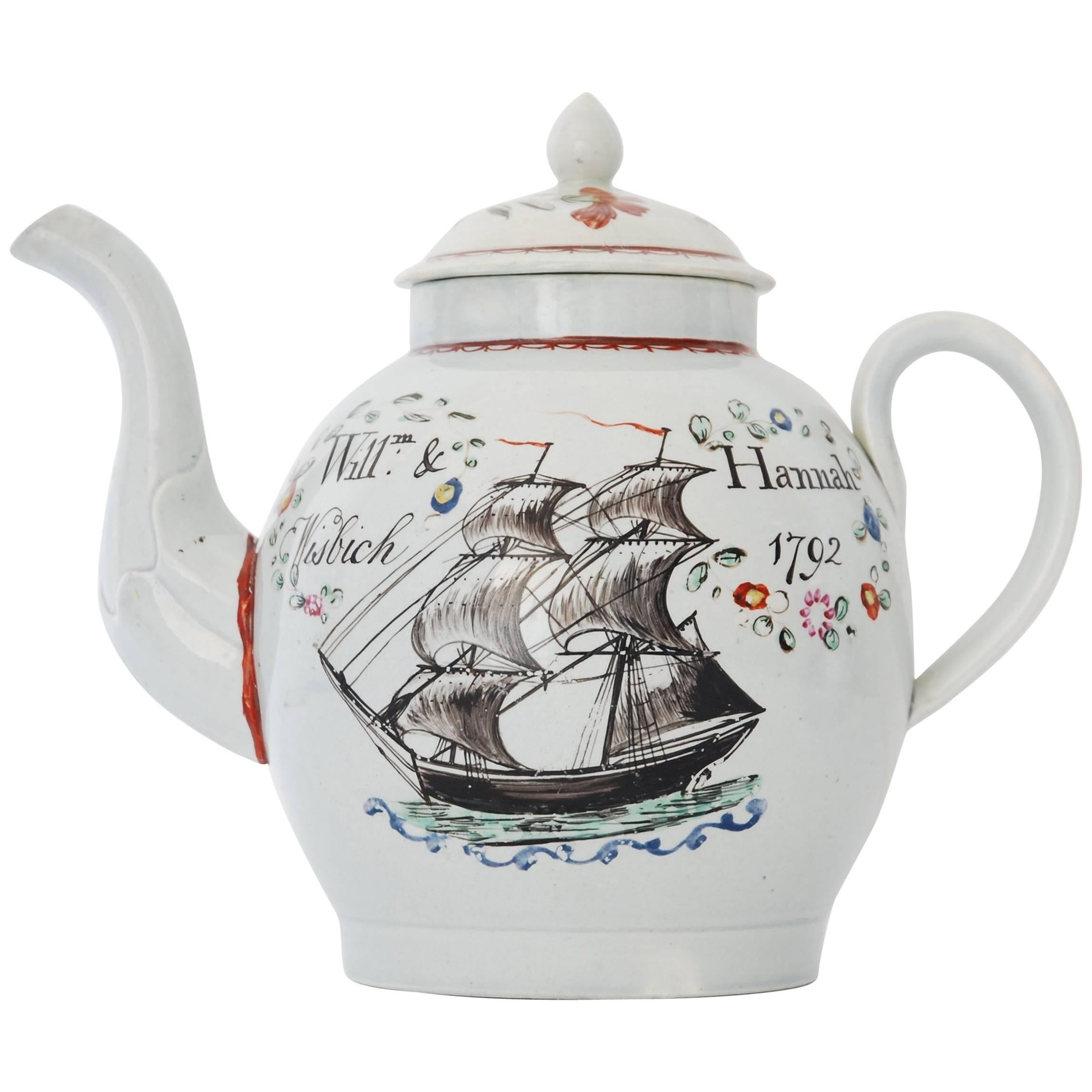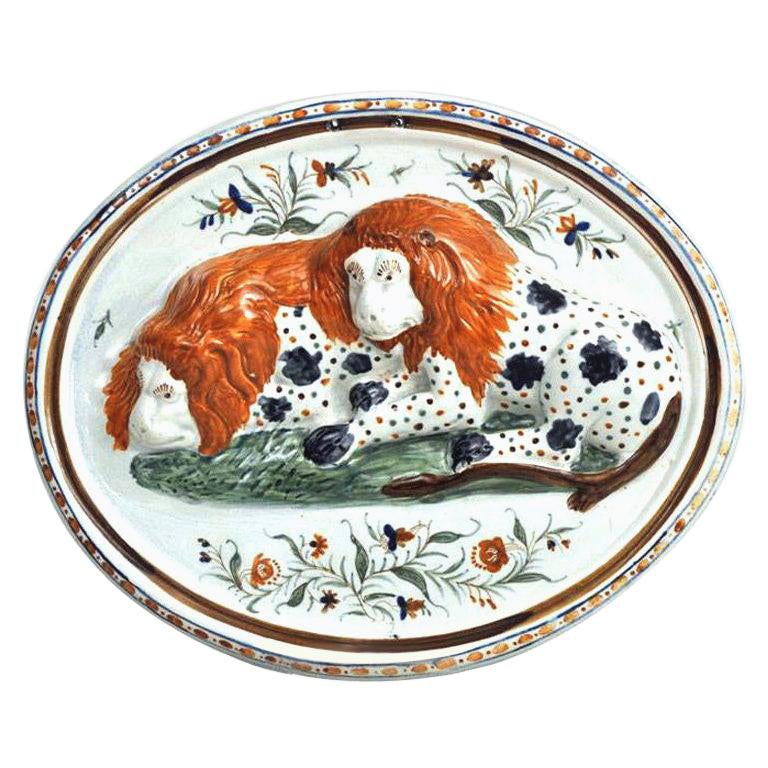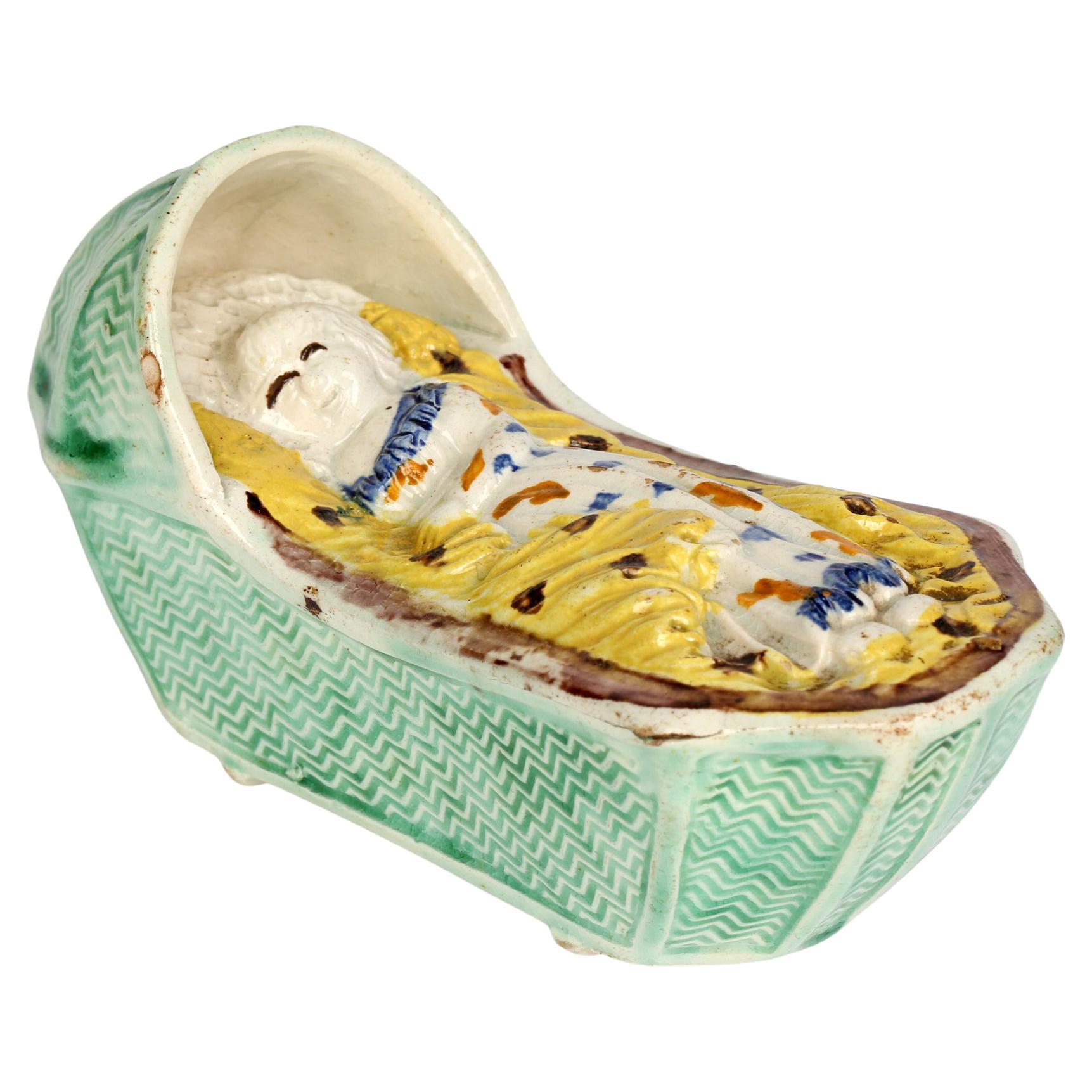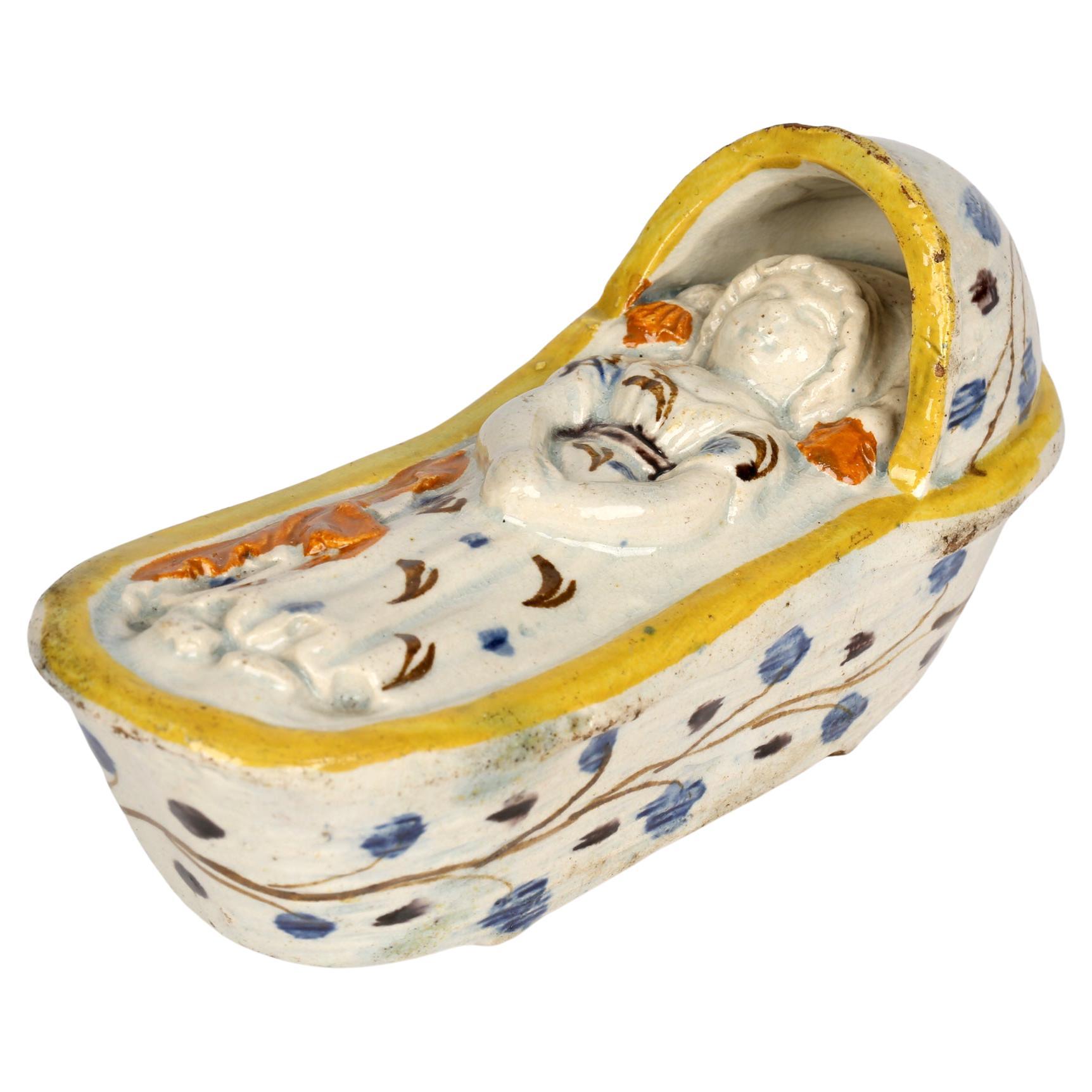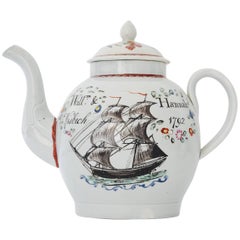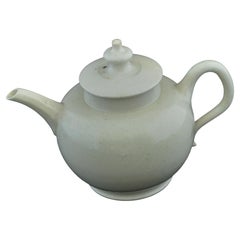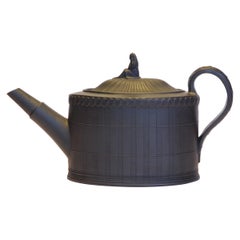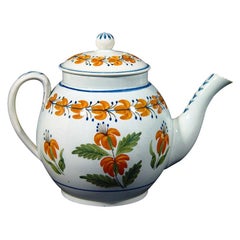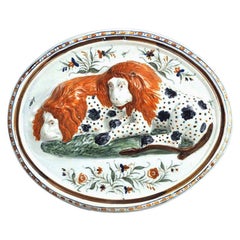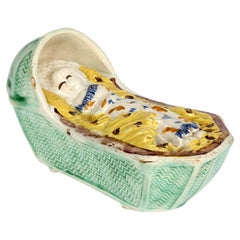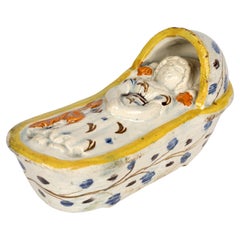Items Similar to Prattware Teapot, Dated 1792
Want more images or videos?
Request additional images or videos from the seller
1 of 8
Prattware Teapot, Dated 1792
About the Item
A documentary teapot, in pearl ware with Pratt ware colors under glaze. Dated and inscribed for Sarah Jackson. Attributed to the Swinton Pottery.
- Attributed to:Swinton Pottery (Maker)
- Dimensions:Height: 6 in (15.24 cm)Width: 8 in (20.32 cm)Depth: 6 in (15.24 cm)
- Style:Neoclassical (Of the Period)
- Materials and Techniques:Pearlware,Turned
- Place of Origin:
- Period:1790-1799
- Date of Manufacture:1792
- Condition:A few edge chips as pictured.
- Seller Location:Melbourne, AU
- Reference Number:Seller: 35811stDibs: LU315139878821
About the Seller
5.0
Vetted Professional Seller
Every seller passes strict standards for authenticity and reliability
Established in 2005
1stDibs seller since 2017
78 sales on 1stDibs
Typical response time: 1 hour
- ShippingRetrieving quote...Shipping from: Melbourne, Australia
- Return Policy
Authenticity Guarantee
In the unlikely event there’s an issue with an item’s authenticity, contact us within 1 year for a full refund. DetailsMoney-Back Guarantee
If your item is not as described, is damaged in transit, or does not arrive, contact us within 7 days for a full refund. Details24-Hour Cancellation
You have a 24-hour grace period in which to reconsider your purchase, with no questions asked.Vetted Professional Sellers
Our world-class sellers must adhere to strict standards for service and quality, maintaining the integrity of our listings.Price-Match Guarantee
If you find that a seller listed the same item for a lower price elsewhere, we’ll match it.Trusted Global Delivery
Our best-in-class carrier network provides specialized shipping options worldwide, including custom delivery.More From This Seller
View AllDated Pearlware Teapot with Ship, English, 1792
By Leeds Pottery
Located in Melbourne, Victoria
A fine documentary teapot, probably made to record a marriage between a sailor and his lass. Pearlware, enamelled with a square-rigged schooner.
Category
Antique Late 18th Century English Neoclassical Pottery
Materials
Earthenware
Black Basalt Teapot, Turner, circa 1805
By Turner Pottery
Located in Melbourne, Victoria
A fine teapot with D-shape handle and a peculiar finial in the form of a widow without her barrel & cruze.
The finial confirms the Turner attribution.
Category
Antique Late 18th Century English Neoclassical Pottery
Materials
Stoneware
Miniature Salt Glaze teapot, English, circa 1760
Located in Melbourne, Victoria
A fine, one-cup teapot in undecorated salt-glazed earthenware. The size reflects the early custom of a pot to each tea drinker.
Category
Antique Mid-18th Century English Neoclassical Pottery
Materials
Stoneware
Oval Teapot in Black Basalt, Turner, circa 1790
By John Turner
Located in Melbourne, Victoria
An excellent black basalt teapot, with engine turned decoration and widow finial. Most unusually, this example is marked.
Category
Antique Late 18th Century English Neoclassical Pottery
Materials
Stoneware
Teapot, Aurora, Goddess of the Dawn, Greatbtach, C1765
By William Greatbatch
Located in Melbourne, Victoria
A classic Greatbatch teapot, with ear-shaped handle, double-flower finial, and “Aurora, Goddes of the Dawn” decoration.
Prov: Kantar Collection.
Category
Antique Late 18th Century English Neoclassical Pottery
Materials
Creamware
$3,200 Sale Price
20% Off
Small Teapot in Caneware with Spaniel Finial. Wedgwood, circa 1820
By Wedgwood
Located in Melbourne, Victoria
An unglazed caneware teapot of depressed oval shape, with arabesque decoration and a spaniel finial.
Wedgwood caneware is a type of pottery that w...
Category
Antique 1820s English Neoclassical Pottery
Materials
Stoneware
$800 Sale Price
20% Off
Free Shipping
You May Also Like
English Pottery Pearlware Teapot with Unusual Prattware Orange Flowers
Located in Downingtown, PA
Charming folky fresh pottery teapot decorated with flowers in distinct orange and green in a good large size.
Category
Antique Early 19th Century English Folk Art Pottery
Materials
Pearlware, Pottery
Regency Prattware Pearlware Pottery Plaque of Lions
Located in Downingtown, PA
The Prattware pearlware plaque is relief-mouded with two recumbent lions and painted in under glaze colors with floral branches and a molded border. What is so nice about this partic...
Category
Antique Early 19th Century English Regency Pottery
Materials
Pearlware, Pottery
Prattware English Pottery Cradle with a Sleeping Child
Located in Bishop's Stortford, Hertfordshire
A fine antique Georgian English Prattware pottery cradle containing a sleeping child dating from around 1800. The cradle sits raised on two rockers a...
Category
Antique 1790s English George III Figurative Sculptures
Materials
Pottery
Prattware English Pottery Cradle with a Sleeping Child
Located in Bishop's Stortford, Hertfordshire
A fine antique Georgian English Prattware pottery cradle containing a sleeping child dating from around 1800. The cradle sits raised on two rockers a...
Category
Antique 1790s English George III Figurative Sculptures
Materials
Pottery
Prattware Pottery Pearlware Tea Canister, Macaroni Figures
Located in Downingtown, PA
Prattware English Pottery Pearlware Tea Canister,
Macaroni Figures,
Possibly Bankfoot Pottery, Prestonpans. Scotland,
Circa 1790-1800.
The pearlware pottery tea caddy is decorated with "Macaroni" figures. On one side is depicted a gentleman wearing an exaggeratedly high wig with his servant standing beside him. On the other side is a similarly caricatured lady and her servant.
The caddy was possibly made in Scotland at Prestonpans where plaster of Paris moulds were recovered during excavations. Plaster of Paris moulds recovered during excavations below the floor of the Belfield Pottery in Prestonpans and almost certainly dumped from the earlier Bankfoot pottery.
Dimensions: 5 1/8 inches high x 3-1/4 inches wide x 2 inches deep.
Condition: Good with a small firing line to the foot-see photo.
The figures depicted on the tea caddy are modelled in very full relief and painted in green and brown. The narrow sides of the tea caddy are painted with a flowering vine. In the canted corners of the caddy is a stylized underglaze blue leaf.
During the 18th century, "macaroni" was the satirical term for men who sported elaborate clothing and continental affectations. Lampooning various occupations and specific styles, these are reproductions of period cartoons.
These amusing figures are after English caricatures produced between 1765 and 1790. The satirical jibes were directed at the young moderns of the time, known as "macaronies."
A group of privileged young Englishmen adopted styles and manners they had admired during their travels in Italy and France. They formed the Macaroni Club (macaroni being virtually unknown in England at the time), an eating club where they vied with one another in matters of dress and manners. Extremes developed and soon spread into larger society. With ribbon-and-lace festooned clothing, prim-verging-on-prissy manners and absurd coiffures, macaronies (both male and female) were subjects of ridicule.
Provenance: Private Maine Collection
Reference:
Haggarty, G 2010 ‘The Belfield Pottery Production Site Ceramic Resource Disk: The Northern Ceramic Society Journal Vol 26 (2009-10), 142-3 + CD ROM.
Pratt Ware: English and Scottish Relief Decorated and Underglaze Coloured Earthenware, 1780-1840, John and Griselda Lewis, Page 234.
Earle: The Earle Collection of Early Staffordshire...
Category
Antique Early 19th Century Scottish Georgian Pottery
Materials
Pottery
Prattware Pottery Macaroni Tea Caddy, Possibly Prestonpans. Scotland
Located in Downingtown, PA
Prattware English Pottery Pearlware Tea Canister,
Macaroni Figures,
Possibly Bankfoot pottery, Prestonpans. Scotland or Staffordshire,
Circa 1790-1800.
The pearlware pottery tea caddy is decorated with Macaroni figures. On one side is depicted a gentleman wearing an exaggeratedly high wig with his servant standing beside him. On the other side is a similarly caricatured lady and her servant.
Dimensions: 5 inches High x 3-1/4 inches Wide x 2 inches Deep.
Condition: Glaze imperfection to neck.
The caddy was possibly made in Scotland at Prestonpans where plaster of Paris moulds were recovered during excavations.
Plaster of Paris moulds recovered during excavations below the floor of the Belfield Pottery in Prestonpans and almost certainly dumped from the earlier Bankfoot pottery.
The figures are modelled in very full relief and painted in green and brown. The narrow sides of the tea caddy are painted with a flowering vine. In the canted corners of the caddy is a wavy underglaze blue line.
During the 18th century, "macaroni" was the satirical term for men who sported elaborate clothing and continental affectations. Lampooning various occupations and specific styles, these are reproductions of period cartoons.
These amusing figures are after English caricatures produced between 1765 and 1790. The satirical jibes were directed at the young moderns of the time, known as "macaronies."
A group of privileged young Englishmen adopted styles and manners they had admired during their travels in Italy and France. They formed the Macaroni Club (macaroni being virtually unknown in England at the time), an eating club where they vied with one another in matters of dress and manners. Extremes developed and soon spread into larger society. With ribbon-and-lace festooned clothing, prim-verging-on-prissy manners and absurd coiffures, macaronies (both male and female) were subjects of ridicule.
Provenance: Private Maine Collection
Reference:
Haggarty, G 2010 ‘The Belfield Pottery Production Site Ceramic Resource Disk: The Northern Ceramic Society Journal Vol 26 (2009-10), 142-3 + CD ROM.
Pratt Ware: English and Scottish relief decorated and underglaze coloured earthenware, 1780-1840, John and Griselda Lewis, Page 234.
Earle: The Earle Collection of Early Staffordshire Pottery...
Category
Antique Early 19th Century Scottish Georgian Pottery
Materials
Pearlware, Pottery
Recently Viewed
View AllMore Ways To Browse
Ouida George
Outdoor Chaise Set Neoclassical
Outdoor Dining Table Concrete Bar Height
Outdoor Rattan Furniture Brown Jordan
Outdoor Wicker Settee
Outstanding Carved Hardwood Anglo Indian
Oxford Ltd Fine Furniture Chicago
Oyster Shucker
Ozoo Desk
P Bessa
P Imans
P Lopez G
P O Steamship
P51 Mustang
Pablo Picasso Serigraph On Silk
Pablo Zabal
Pace Burl Wood Executive Desk 1970
Pace Canopy Bed
